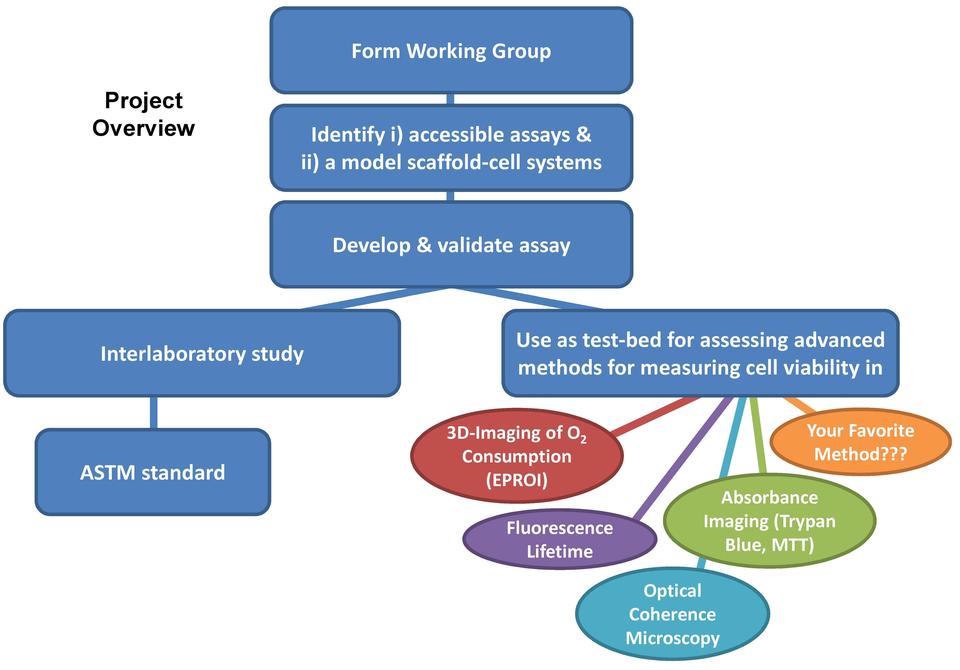Measuring Cell Viability in Scaffolds
Project Goals
Primary Goal: Advance measurements of cell viability in manufactured tissues
- Establish working group of industry stakeholders to guide work
- Develop model scaffold-cell-assay system for measuring cell viability in scaffolds
- Validate measurement system by orthogonal test methods
- Assess reproducibility of measurement system by conducting an inter-laboratory test
- Write ASTM standard test method for measuring cell viability in scaffolds, supported by results from work described above
- Use model scaffold-cell-assay system to assess advanced methods for measuring cell viability in scaffolds (especially non-invasive imaging methods)
Motivation
- Tissue engineered medical products are often composed of cells on a scaffold
- Cell viability is often measured as a quality attribute of tissue engineered medical products
- Viable cells are often required for the intended mechanism of action, whereby live cells regenerate tissue or secrete factors to induce regeneration.
- However, the scaffold may interfere with viability tests in a variety of unknown ways.
- The scaffold may slow diffusion of assay components into and out of the scaffold.
- The scaffold may interact with the assay components to affect assay results.

Credit:
Deepika Arora
Working Group Members
- Carl Simon, NIST
- Terry Riss, Promega
- Liisa Kuhn, University of Connecticut
- Kaiming Ye, Binghamton University
- Michael Hiles, Cook Biotech.
- Esmaiel Jabbari, University of South Carolina
- Carla Divieto, INRIM
- Ivan Rich, Hemogenix
- Connie Lebakken, StemPharm
- Mrignayani Kotecha, O2M Technologies
- David Kennedy, National Research Council, Canada
Scaffold - Cell - Assay System
- Scaffold: Glucose-Based Polysaccharide Gel
- Hydrogel represents the “worst-case scenario” for interfering with bioassays (slowing diffusion of assay components)
- Shear thinning gel which can be disassembled by pipetting action: this is key for releasing cells from gel to confirm in situ-results
- Source: VitroGel (TheWell Bioscience)
- Assay: ATP/DNA
- ATP Luminescence Assay
- Bioluminescence assay for quantitative determination of ATP (moles)
- Used for release of haematopoetic stem cells for clinical use
- Source: CellTiterGlo-3D Luciferase Assay (Promega)
- Fluorescence DNA assay
- Fluorescence assay for quantitative determination of ATP (grams)
- Source: PicoGreen dsDNA Assay Kit (ThermoFisher)
- ATP Luminescence Assay
- Cells: Jurkat
- Human T lymphocytes
- Non-adherent cells should not undegro anoikis in polysaccharide hydrogel that lacks cell adhesion sites
- Source: Jurkat, Clone E6-1, ATCC TIB-152
Validation Scheme
This is a high-level overview of the types of tests being conducted to develop the validated test method
Luminescence ATP assay
- ATP spike-into hydrogel
- ATP spike-into hydrogel then disassembly via shear-thinning
- Jurkat Cells in hydrogel
- Jurkat Cells in hydrogel then disassembly via shear-thinning
Fluorescence DNA assay
- DNA spike-into hydrogel
- DNA spike-into hydrogel then disassembly via shear-thinning
- Jurkat Cells in hydrogel
- Jurkat Cells in hydrogel then disassembly via shear-thinning

Credit:
Carl Simon
Value
It is intended that this test system, the protocols and the ASTM standard may serve the following purposes:
- Guide for researchers for developing a strategy for validating measurements of cell viability in scaffolds.
- Used as a training tool for scientists that are learning to measure cell viability in scaffolds.
- The model scaffold-cell-assay system may be used as a test bed to assess advanced measurements of cell viability in scaffolds, especially less invasive or 3D imaging techniques (EPROI, photonic sensing, photoacoustic imaging, fluorescence lifetime, optical coherence tomography).
ASTM Work Item
WK62115: Standard Test Method for Measuring Cell Viability in a Scaffold
Get Involved
If you would like to join our working, participate in the interlaboratory study, or have an imaging method that you would like to test with this model system, then please reach out to Carl Simon (carl.simon [at] nist.gov (carl[dot]simon[at]nist[dot]gov)).
Contributors
Carl Simon, Greta Babakhanova, Deepika Arora, Allison Horenberg
Created November 25, 2019, Updated July 9, 2021

